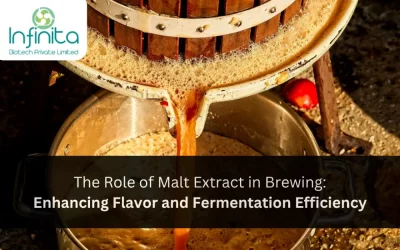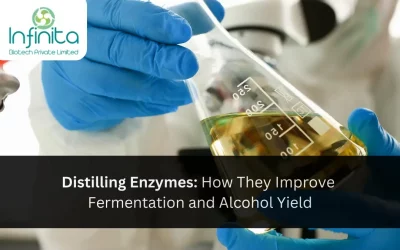In the world of sugar processing, efficiency is key. The ability to produce high yields of sugar while minimizing energy consumption and costs can make a significant difference in the success and profitability of a processing plant. One way to achieve this efficiency is through the use of enzymes, which play a vital role in the sugar processing industry.
Understanding the Sugar Processing Industry
Sugar production is a complex process that involves extracting sugar from raw plant materials, such as sugarcane or sugar beets. The raw materials undergo various stages of processing, including extraction, purification, and crystallization, to obtain the final product – sugar.
The Basics of Sugar Production
The journey from raw plant materials to refined sugar begins with extraction. The sugarcane or sugar beets are crushed to release the juice, which contains sucrose, the main component of sugar. This juice is then clarified to remove impurities before undergoing further processing.
Next comes the purification stage. Here, the juice is heated and treated with lime to remove any remaining impurities. The resulting liquid is further concentrated by boiling until the sugar begins to crystallize. The mixture is then spun in centrifuges to separate the sugar crystals from the liquid, a process known as crystallization.
Finally, the sugar crystals are dried, screened, and packaged, ready for distribution to consumers or further processing for specialized sugar products.
Key Challenges in Sugar Processing
Sugar processing presents several challenges that can impact efficiency. One major challenge is the presence of non-sugar components in the raw materials, such as fiber and proteins, which can hinder the extraction process and reduce sugar yields.
Another challenge is the formation of unwanted by-products, such as invert sugar and melanoidins. Invert sugar, formed from the breakdown of sucrose, can negatively impact the quality of the final sugar product. Melanoidins, which are brown pigments formed during heating, can cause discoloration and affect the sugar’s aesthetic appeal.
Moreover, the sugar processing industry also faces environmental challenges. The extraction process generates a significant amount of waste material, known as bagasse, which consists of crushed sugarcane stalks. Finding sustainable uses for bagasse is an ongoing concern for the industry, as it has the potential to be used as a renewable energy source or as a raw material for the production of paper and other products.
In addition to environmental challenges, the sugar processing industry also grapples with economic factors. The industry is highly dependent on factors such as weather conditions, global sugar prices, and government policies. Fluctuations in these factors can significantly impact the profitability and stability of sugar processing companies, making it a challenging industry to navigate.
Furthermore, technological advancements play a crucial role in overcoming the challenges faced by the sugar processing industry. Innovations in extraction methods, purification techniques, and crystallization processes have helped improve efficiency and increase sugar yields. Additionally, research and development efforts are focused on finding ways to minimize the formation of unwanted by-products and develop sustainable solutions for waste management.
In conclusion, the sugar processing industry is a complex and dynamic sector that involves multiple stages of processing to transform raw plant materials into refined sugar. It faces challenges related to extraction, purification, by-product formation, environmental sustainability, and economic factors. However, through technological advancements and continuous research, the industry strives to overcome these challenges and meet the growing demand for sugar in a sustainable and efficient manner.
The Role of Enzymes in Sugar Processing
Enzymes are natural catalysts that can enhance the efficiency of sugar processing. These biological molecules speed up chemical reactions, enabling sugar extraction and purification to occur more rapidly and effectively.
Enzymes are essential in the realm of sugar processing, where their catalytic prowess is harnessed to optimize various stages of production. From the initial extraction of sugars from raw materials to the final purification processes, enzymes are pivotal in ensuring high yields and superior quality in the end product.
What are Enzymes?
Enzymes are proteins that occur naturally in living organisms. They act as catalysts in biochemical reactions, facilitating the conversion of substrates into products without being consumed in the process. In the context of sugar processing, enzymes can break down complex carbohydrates, such as cellulose, into simpler sugars, increasing sugar yields.
These remarkable proteins possess highly specific active sites that enable them to interact with particular substrates, ensuring precision in their catalytic activities. Through a process called induced fit, enzymes undergo conformational changes to accommodate the substrate, leading to efficient catalysis and product formation.
How Enzymes Work in Sugar Processing
In sugar processing, enzymes target specific components, such as fiber and proteins, in the raw materials. They break down these components into smaller molecules that are more easily extractable. This leads to improved sugar yields and reduces the amount of non-sugar substances in the juice.
Enzymes also play a role in reducing unwanted by-products. For example, enzymes can break down invert sugar, preventing its accumulation and improving the quality of the final sugar product. Additionally, enzymes can modify the structure of melanoidins, reducing their formation and minimizing discoloration.
Moreover, enzymes contribute to sustainability in sugar processing by enabling milder processing conditions, which in turn reduce energy consumption and environmental impact. By operating under mild temperatures and pH levels, enzymes offer a greener alternative to traditional chemical methods, aligning with the growing emphasis on eco-friendly practices in the food industry.
Boosting Efficiency in Sugar Processing with Enzymes
The use of enzymes in sugar processing can significantly enhance efficiency in several ways.
The Impact of Enzymes on Sugar Yield
Enzymes increase sugar yield by breaking down complex carbohydrates that would otherwise be difficult to extract. By effectively converting these components into simpler sugars, enzymes ensure a higher quantity of sugar is obtained from the same amount of raw materials.
This increased sugar yield not only improves the overall efficiency of the processing plant but also maximizes the use of available resources. With enzymes, less raw material is wasted, resulting in a more sustainable and cost-effective process.
Enzymes and Energy Efficiency
Another benefit of using enzymes in sugar processing is improved energy efficiency. By accelerating the rate of chemical reactions, enzymes reduce the need for high-temperature processing and extended processing times. This, in turn, leads to energy savings and lower operating costs for the processing plant.
Moreover, enzymes can enable the use of milder processing conditions, which can be gentler on the equipment and infrastructure, minimizing the need for frequent maintenance and repairs.
Implementing Enzyme Technology in Sugar Processing
Integration of enzyme technology into sugar processing requires careful consideration and planning.
Choosing the Right Enzymes for Sugar Processing
Not all enzymes are suitable for every sugar processing application. Different enzymes have specific target substrates and functions. Therefore, it is essential to select the appropriate enzymes that can effectively address the challenges and requirements of a particular processing plant.
Collaboration with enzyme manufacturers and experts in the field can help determine the most suitable enzyme solutions based on the plant’s specific needs, raw materials, and desired outcomes.
The Process of Integrating Enzymes into Production
Integrating enzymes into sugar processing involves multiple steps, from enzyme preparation to implementation and monitoring.
Firstly, the enzymes need to be prepared and optimized under controlled laboratory conditions. This includes determining the ideal enzyme dosage, pH, temperature, and reaction time for each specific application.
Once the enzyme formulation is finalized, pilot-scale trials can be conducted to assess the effects on sugar yield, product quality, and process efficiency. These trials help refine the enzyme application and identify any potential challenges or adjustments needed for full-scale implementation.
Finally, the enzymes can be integrated into the production process, with proper monitoring and quality control measures in place. Regular analysis and adjustments can be made to optimize enzyme performance and ensure consistent results.
The Future of Enzyme Use in Sugar Processing
With advancements in enzyme technology, the future of sugar processing looks even sweeter.
Innovations in Enzyme Technology
Researchers and manufacturers continue to develop new enzyme formulations and improve existing ones to address specific challenges in sugar processing. These innovations aim to enhance sugar yield, reduce processing time, and further optimize energy efficiency.
For example, enzymes that are more robust, efficient, and cost-effective are being developed to support large-scale sugar processing operations. Additionally, enzymes are being engineered to have specific properties, such as increased thermal stability or broader substrate specificity, making them even more versatile and effective in various processing conditions.
Predicted Trends for Enzymes in Sugar Processing
As the demand for sustainable and resource-efficient solutions increases, enzymes are expected to play an even more significant role in sugar processing in the future.
One emerging trend is the use of enzyme cocktails, where multiple enzymes with complementary functions are combined to achieve enhanced overall performance. These cocktails can target a broader range of substrates and optimize multiple aspects of the sugar processing workflow simultaneously.
Furthermore, enzymes are likely to be integrated into integrated biorefinery systems, where multiple products and value streams are obtained from the same raw materials. This holistic approach maximizes resource utilization and diversifies revenue streams, aligning with the principles of the circular economy.
Conclusion
Enzymes offer great potential for boosting efficiency in the sugar processing industry. Through their ability to enhance sugar yield, reduce processing time, and improve energy efficiency, enzymes are revolutionizing the way sugar is produced. With ongoing advancements in enzyme technology, the future of sugar processing looks promising, with even sweeter results on the horizon.







